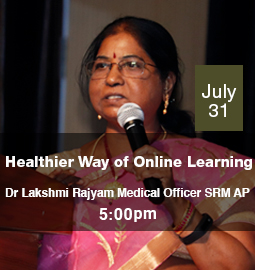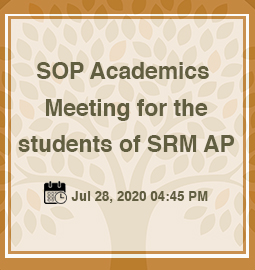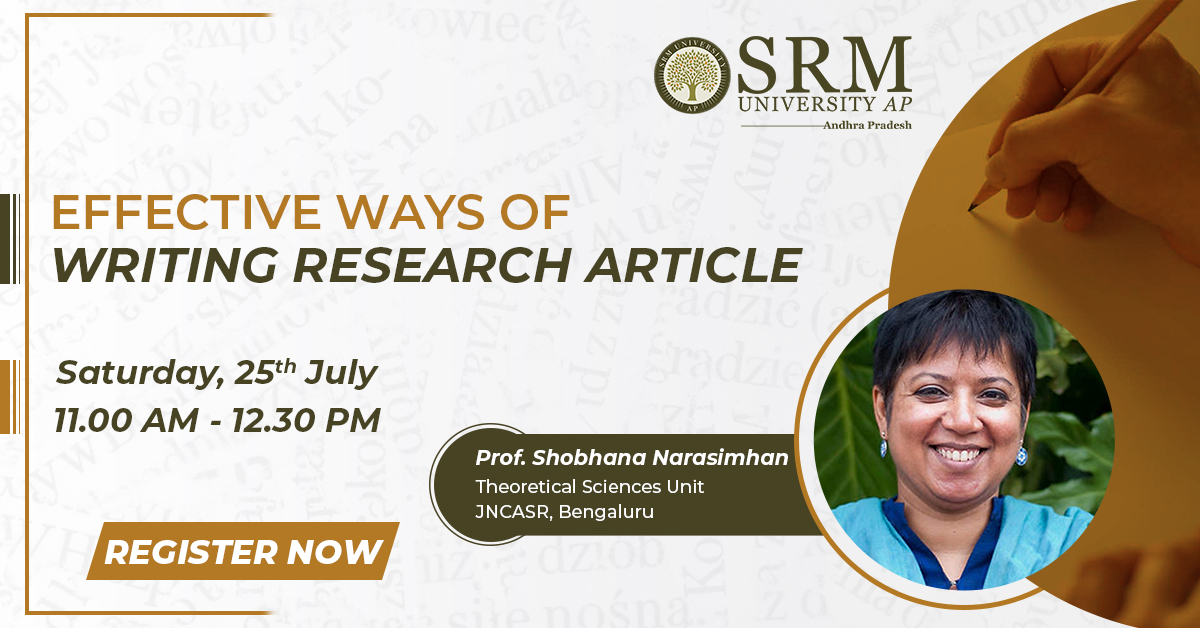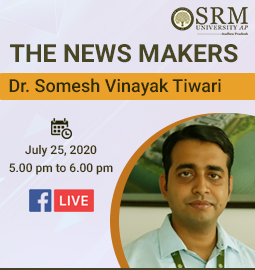- Department of Student Affairs organizes “Healthier Way of Online Learning” July 31, 2020
 SRM University-AP, Andhra Pradesh will be commencing online classes for the upcoming semester from next week onwards. Considering the apprehension of the students regarding the health issues associated with the online classes, the Department of Student Affairs, SRM AP organizes a webinar where Dr Lakshmi Rajyam, Medical Officer, SRM AP will enable you to understand the healthier approach to online learning. Attend this benefitting webinar on 31st July 2020 at 5 p.m.
SRM University-AP, Andhra Pradesh will be commencing online classes for the upcoming semester from next week onwards. Considering the apprehension of the students regarding the health issues associated with the online classes, the Department of Student Affairs, SRM AP organizes a webinar where Dr Lakshmi Rajyam, Medical Officer, SRM AP will enable you to understand the healthier approach to online learning. Attend this benefitting webinar on 31st July 2020 at 5 p.m.Registration Link: Please Click Here
Continue reading → - Department of Student Affairs organizes “SOP Academics Meeting” July 28, 2020
 Department of Student Affairs, SRM University-AP, Andhra Pradesh organizes the SOP Academics Meeting for the students of SRM AP on 28th July, 2020 at 4.45 p.m. During this internal session, the speakers and participants will discuss the protocols that would ensure a beneficial future of the students amidst the pandemic.
Department of Student Affairs, SRM University-AP, Andhra Pradesh organizes the SOP Academics Meeting for the students of SRM AP on 28th July, 2020 at 4.45 p.m. During this internal session, the speakers and participants will discuss the protocols that would ensure a beneficial future of the students amidst the pandemic.Registration Link: Please Click Here
Continue reading → - SRM AP organized webinar on “EFFECTIVE WAYS OF WRITING RESEARCH ARTICLE” July 26, 2020
Prof Shobhana Narasimhan on “How to publish without perishing”
 SRM University-AP, Andhra Pradesh organized a webinar titled “EFFECTIVE WAYS OF WRITING RESEARCH ARTICLE” to enhance the opportunities endowed to young scholars that would enable them to demonstrate their expertise and improve their critical analyzing skills. Prof D. Narayana Rao, Pro-Vice Chancellor, welcomed the guest speaker Prof Shobhana Narasimhan, Theoretical Sciences Unit, Jawaharlal Nehru Centre for Advanced Scientific Research (JNCASR), Bengaluru, and participants of the webinar through his opening remarks. Prof D. Narayana Rao explained the importance of higher education and research as they are critical contributors to sustainable livelihood and the economic development of the nation. He said, “Research serves as a hub to harbour innovative ideas that enlighten and propel the country forward socially, culturally, scientifically, technologically, and economically. In view of the requirements of the 21st century, the aim of quality university education is to develop good well rounded and creative individuals. Higher education and research must enable knowledge creation and innovation, thereby contributing to the economy.”
SRM University-AP, Andhra Pradesh organized a webinar titled “EFFECTIVE WAYS OF WRITING RESEARCH ARTICLE” to enhance the opportunities endowed to young scholars that would enable them to demonstrate their expertise and improve their critical analyzing skills. Prof D. Narayana Rao, Pro-Vice Chancellor, welcomed the guest speaker Prof Shobhana Narasimhan, Theoretical Sciences Unit, Jawaharlal Nehru Centre for Advanced Scientific Research (JNCASR), Bengaluru, and participants of the webinar through his opening remarks. Prof D. Narayana Rao explained the importance of higher education and research as they are critical contributors to sustainable livelihood and the economic development of the nation. He said, “Research serves as a hub to harbour innovative ideas that enlighten and propel the country forward socially, culturally, scientifically, technologically, and economically. In view of the requirements of the 21st century, the aim of quality university education is to develop good well rounded and creative individuals. Higher education and research must enable knowledge creation and innovation, thereby contributing to the economy.”Prof D. Narayana Rao believes that institutes must build expertise that will impact the society for the next 3 decades and beyond. Prof D. Narayana Rao explained, “Simply tailoring people into jobs that exist today but are likely to change or disappear in the coming years, is suboptimal and even counterproductive. The universities and educational institutions need to instill the thought process and inquisitiveness among students by going beyond the classroom and expanding the frontiers of knowledge.” He urged that there is a dire need to emphasize the pride and prestige associated with research to make the students feel honoured and excited for undertaking scientific pursuits. Prof D. Narayana Rao informed, “At SRM AP, we encourage undergraduate and graduate students to get involved in research. This country has the legacy of producing young scientists who have published papers in highly reputed journals. Realizing that, we do encourage undergraduate students to get involved with research and publish papers in good journals. This also familiarizes our students to a research-intensive environment, benefiting them in their future endeavours”. Prof D. Narayana Rao concluded by requesting Prof Shobhana Narasimhan to motivate the students to carry out research and publish good research journals, believing that she will hypnotize the participants and inspire them to succeed.
Prof Shobhana Narasimhan began the presentation, “How to publish without perishing” with the purpose of improving the articles so that they find places in good journals. She initiated her talk by saying that writing papers is an integral part of the scientific research pursuits. Quoting Francois Arago: “To get to know, to discover and to publish in the destiny of the scientist”, and Robert Boyle: “Writing about science should be clear but it can also be made beautiful”, she explained the rules of effective research writing.
Prof Shobhana Narasimhan said that foremost, one needs to identify the reason for their willingness to write a paper. Further, she elaborated on the first rule of effective writing by mentioning that one should choose the journal carefully before writing the paper as the article should be aligned to the requirements and regulations of the particular journal in mind. Also, she suggested that one has to consider the extent of the readership of the journal, difficulty in getting the paper published in the journal, prestige associated with publishing in the journal, payment involved with the publishing, and the time required for the article to be published in the journal. She also said, “Often, invitations come from predatory journals and one should research carefully regarding the same. A publish in a predatory journal becomes a black mark in your career. It is better to go through the struggle of publishing in a respected journal than to go for the easy options”.
Prof Shobhana Narasimhan also speaks of constructing a story while writing the paper. She insisted, “The most important rule is to narrate a story while writing a paper. It is not just about calculations and results.” She explained the 3 steps associated with constructing the story. First, the research scholars require to ‘assemble the materials’. Depending on the requirement, one can use either of the three techniques: ‘mind maps’ which works better when there is one main concept and one can start from the centre, the second is ‘concept maps’ which works better when one has several related concepts and can use a flowchart to structure it from the top, and the third one is ‘timelines’ which works mostly with review articles, where a chronological sequence is used to assemble the materials. Prof Shobhana Narasimhan moved on to discuss the second step – ‘keeping and discarding information’. She used a schematic diagram to explain the usual proceedings of a scientific research. She said, “The path to scientific discovery is a complex tree-like structure. One does not need to describe all the blind alleys encountered during the research, a specific and balanced representation would be the ideal path to traverse.” Further, in the third step, one must ‘arrange the materials in a sequence’ which can be chronological or logical. Prof Shobhana Narasimhan informed, “In a scientific paper, a logical sequence is usually preferred. Play with the facts and results to construct a narrative and structure the argument in a flowchart to improve the efficiency.”
Prof Shobhana Narasimhan explained another rule: ‘clear what your message is’. She said, “The article should not be too clear, but it should be as clear as possible. Possible messages that one can provide in a paper include the most significant result, the second most significant result, new techniques and approach presented in the work or the existing method used in a new area, and whether the work contradicts/confirms the existing expectations.” She concluded by mentioning that the scholars need to tailor the paper to the journal’s audience by considering whether they are likely to be experts or laymen. This would allow the writer to construct the appropriate language for the paper and decide on the extent of information to be shared. She also urged researchers to use simple words when possible, check for grammatical errors, avoid plagiarism, abide by the journal’s style guidelines, and include a cover letter to increase the probability of getting their research articles published in reputed journals.
Continue reading → - The Newsmakers: An interview with Dr Somesh on his journey as a researcher July 25, 2020
 Dr Somesh Vinayak Tiwari, Assistant Professor, Department of Electrical and Electronics Engineering, joins The Newsmakers session on 25th July 2020 at 5 pm. Dr Somesh Vinayak Tiwari was awarded the prestigious “Outstanding Doctoral Students Award”, from Homi Bhabha National Institute (HBNI) at an event held at the Department of Atomic Energy (DAE) Convention Centre, Anushaktinagar, Mumbai. Dr Tewari was presented this award for his excellent PhD thesis titled “Study of surface flashover of insulator in gases at high pressure.” In the session of The Newsmaker, he will be interviewed by Dr Anuj Deshpande, Assistant Professor, Department of Electronics and Communication Engineering, on his journey as a doctoral scholar and researcher.
Dr Somesh Vinayak Tiwari, Assistant Professor, Department of Electrical and Electronics Engineering, joins The Newsmakers session on 25th July 2020 at 5 pm. Dr Somesh Vinayak Tiwari was awarded the prestigious “Outstanding Doctoral Students Award”, from Homi Bhabha National Institute (HBNI) at an event held at the Department of Atomic Energy (DAE) Convention Centre, Anushaktinagar, Mumbai. Dr Tewari was presented this award for his excellent PhD thesis titled “Study of surface flashover of insulator in gases at high pressure.” In the session of The Newsmaker, he will be interviewed by Dr Anuj Deshpande, Assistant Professor, Department of Electronics and Communication Engineering, on his journey as a doctoral scholar and researcher. Watch the session live on our official Facebook page and avail the opportunity to know more about a doctoral scholar’s life from someone who has recently experienced it.
Continue reading →

Experience top of the world living and learning at SRM University-AP
+91-863-2343000
080-6988-6999 (admissions)
Email: admissions@srmap.edu.in
SRM University-AP, Neerukonda,
Mangalagiri Mandal, Guntur District, Andhra Pradesh - 522240
